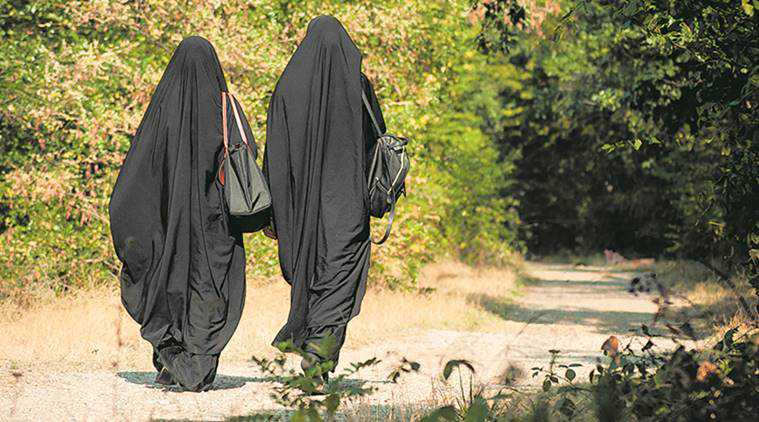In Sri Lanka, the recent ban on face veils raises questions about free will and stirs up memories of a feisty woman who defied conventions.
While we’re still reeling under the shock of the horrendous blasts in Sri Lanka and the new fault line deepening with the anti-Muslim attacks, the recent ban on face veils has stirred a storm in a teacup. Although several Muslim councils and Islamic scholars here have backed the ban for security reasons, yet it has become a hot topic of drawing room discussions. I find myself in similar debates, which my Dadijaan would have been a part of 80 years ago.
Khurshid Banu Tehsin, vice-president, state branch of All India Women’s Congress, of which Maharani Gayatri Devi was the president, was one of the initiators of women’s education movement in southern Rajasthan. She lost a leg in childhood and was married off at the age of nine. After finishing chores given by her disgruntled mother-in-law who was opposed to her son marrying a “langdi” (but the 11-year old Taffazul’s will prevailed), Khurshid would slip out of home and go sit outside the window of a madrasa. That’s how she educated herself. In 1942, she formed Bazm-e-Niswan, a women’s study group, with a library, to spread Gandhi’s message and increase awareness about the country’s sociopolitical situation. She started a girls’ literacy movement in Udaipur, especially to mobilise the conservative Muslim families. This led to cent per cent literacy in the Dawoodi Bohra community of Udaipur in a short span of time.
There were other firsts, too. In the late 1940s, with the backing of my grandfather who was later the mayor of Udaipur, she was the first to send her daughters without a purdah to Vidya Bhawan, one of the first co-educational schools of India. A lot of fists started waving at her, and the townspeople pelted stones at our house. Educate the girl child? Blasphemy! Dadijaan, with one leg and a tremendous will, sent my aunts to school wearing saris, considered a vulgar, modern dress. All the communities — Muslims, Hindus, Christians — were united in their rage. The women didn’t step out without purdah (or in completely covered bagghis). Not just Muslim women. All women. Period.
Today, 80 years hence, I find myself debating not with the radicals but the liberals about face veils being a matter of choice. I am all for free will. Yes, sir, I am. But is it really free? Being a woman, I can tell you that it is either indoctrination or force. My good friends give me parallels of Sikh turbans and Jewish caps. I agree that wearing symbols of religion or not having alcohol or avoiding perfume or even not watching the telly or listening to music are a matter of choice, even though they may stem from conditioning. But covering your face lifelong because you’re a woman? Not entering kitchen during your periods? Women undergoing genital mutilation on grounds of religion? Sati? That is not religion; that is an “exasperating farrago of distortions” in the name of faith.
There are 1.8 billion Muslims in the world, out of which only a fraction are based in the Arab world, where the ultra-conservative Salafi-Wahhabi form of Islam is practised. From the mystical-ascetic Sufis to African-American movements with racial aspects to the Hizmet movement of Turkey concentrating on education, there are multiple branches, sub-branches and schools of Islam with different interpretations. The South Asian Muslims are not a radical community, but radicalisation is trickling in with the Saudi influence.
A decade-and-a-half ago, when we dropped anchor in Sri Lanka, I had high wind in my sails. The island was beautiful, the society progressive and the status of women across ethnic groups seemed better, compared to the larger part of the Indian society. Niqab and burqas were almost unseen. Now it is not an unusual sight on the streets of the capital. The ban on face veil on the island doesn’t single out any religion or name the garment. Before the CIIs (you can see that I am inspired to speak in acronyms) start harping about Islam being banned itself, let me tell them that a Marwari or a Rajput woman from India with a foot-long ghoonghat (veil) would be politely stopped here right at the airport. Oh no, CII doesn’t mean Cocky Internet Idiots. It stands for Civilised Internet Intellectuals.
There are many parts of the world that have banned face veils partially or fully — France, Belgium, Austria, Denmark, Quebec in Canada, Barcelona in Spain, Germany and the Netherlands. It is not just the West banning it. There are bans on niqab in the African countries like Morocco, Chad, Republic of the Congo and Cameroon. What more, the Council of Islamic Ideology conceded that women are not required to cover their faces under Shariah law. Where? Bhaiyon aur behenon, it was in Pakistan!
There are Muslim women in all parts of the world who are speaking up and fighting against gender inequalities and on the imposed limits on their personal freedom. Change has to come from within. The international solidarity network “Women Living Under Muslim Laws” and “Revolutionary Association of the Women of Afghanistan” are a couple of examples. But a helping hand, well, always helps.
To all my liberal friends who are sceptical about the face veil ban in Sri Lanka or who say that you need a British Empire to bell a cat like Sati, I would respectfully disagree. Dadijaan proved that even someone like her, without a leg, could walk right up to the cannon’s mouth.
Arefa Tehsin is an author and environmentalist.
Source: Read Full Article


